
There’s naturally a direct link between the cars that I had as toys and model kits as a child in the ’80s and the cars that still stop me dead in my tracks today. I loved my 1/43rd rallycars (Audis, Saabs, Lancias), my 1/32nd Peugeot 205 T16, Matchbox Porsche K3s and fleet of F1 cars. They were all cars that I’d never seen in real life, but even as a kid I just knew they were special. What I really held up on a pedestal were my father’s Tamiya model kits, painstakingly put together and liveried. Four cars always stood out. A Jaguar XJR9-LM. A Martini-liveried Porsche 935/77. The silver wings of a Ferrari 312 T3 F1.
And then there was the Zakspeed Capri.

My father owned a 2.0s MkIII Capri in the ’80s, in which we used to bomb around Europe (as much as you could with a family of four crammed in and a frame-tent the size of Versailles in the boot). In my head, there was a direct relationship between our lithe white coupé, with its go-fast S stripe down the side (surprisingly, its number plate popped back into my head as I was writing this!), and the brutal German Group 5 machine which sat on the shelf at home.

I tried modifying a regular Capri model kit to look like the Zakspeed car, but it just didn’t work. Nothing could look as aggressive or as striking as the real thing. I couldn’t imagine ever seeing one in real life, especially as they had only once crossed the Channel to race at Donington in 1980, when I was still using stabilisers, let alone holding a steering wheel.

I might have had to wait 25 years, but it was more than worthwhile. This 1981 Group 5 Zakspeed Ford Capri Turbo is sitting in the Zakspeed team’s factory in Niederzissen. It’s been the subject of a painstaking seven-year restoration by original Zakspeed engineer Marco Fichter, which now sees the car in immaculate, as-new condition. It’s a beautiful racing car. It is also a bellowing monster: all flame, wings and raw visceral speed.

Ford were no stranger to aiming punches at those that considered themselves a strata above in automotive terms. Racing saloons were a given, but Ford Formula 1 engines had taken on and beaten Ferrari in the ’60s, and Ford had then stepped into the ring to take on the same marque at Le Mans with the GT40 – and won. Into the ’70s, Ford engines still dominated F1, though saloon cars continued to be bread and butter for the firm, run out of the Cologne operation in Germany.

The wow factor of the Capri coupé had been the perfect weapon to keep Ford in the headlines during the ’70s, and the famous Cologne Capri MkIs battled BMWs, Alfas and Opels across Europe. But even a global company like Ford couldn’t avoid the ’70s fuel crisis: midway through the decade Cologne was closed down, signalling the end of Ford’s in-house European racing facility. As the decade moved on, independent teams continued to campaign Capris and Escorts, and there was one team that crossed over with the factory era: Zakspeed. They’d developed their own highly-tuned BDA-engined Escort RS1600 MkI in cooperation with Ford, representing the Blue Oval in both the European Touring Car Championship and the national Deutsche Rennsport Meisterschaft.

The DRM. There’s something in the water in Germany that means that the country is addicted to having the highest powered, most over the top racers possible in their own national series. Modern DTM racers are the natural descendants of this series, which ran between 1972 and 1985. DRM started off as a pure touring car championship, but then the organisers decided to open up the championship to the fearsome new turbocharged Group 5 silhouette racers, perhaps as a result of a heavy night and half-closed eyes when signing off the regs for 1977.

Not only did it prosper, but it even hoovered up more cars than the international series the fourth generation FIA Group 5 rules had been intended for, the World Championship For Makes. Porsche 935 battled BMWs 320i, Lancia’s brutal Beta Montecarlo and Kremer’s 911 on steroids, the K3, as the ’80s rolled into view.

It was the perfect championship for German teams. If there’s one thing the Germans like it’s the excuse of enormous power in extreme cars, and Zakspeed had been more than happy to oblige Ford with the classic black, red and yellow, Mampe-liveried (among others) Group 2/5 Escort MkII. With the MkIII Capri due to be released in Europe in ’78, Ford wanted the car back in competition – and racing at the highest level possible. So how about Group 5? Zakspeed’s telephone rang again.

The result was the Zakspeed Capri Turbo. Boy racer against the elite. But it was definitely not David versus Goliath, not with what went into this car.

Group 5 rules dictated that the lines of the production model needed to be maintained above the wheel arches, the suspension layout had to be unchanged and the engine taken from a production unit in the manufacturer’s line. Aside from that… Make it wide. Make it low. Make it fast. Very fast. This gave Zakspeed team chief Erich Zakowski and Ford Europe’s Chief Engineer Thomas Ammerschalger a free brief to create a far more purebred racing car than had been allowed with the MkI, and the raked windscreen and long lines of the Capri was an ideal platform for creating a car to fight the BMWs and Porsches on the same terms.

As with most other Group 5 monsters, that meant the A and C pillars were the only things taken from the production car, aside for the odd ancillary like the rear lights.

The Capri was chopped and lowered to the extent that the entire car barely came up to the sill of the original, and big wings and fenders added.

And when I say big, I mean huge. Group 5 was all about overwhelming quantities of aero, maxing out the car to the extreme dimensions of the rules: Bōsōzoku style draws directly from this era of racing car. When you look at the 1978 Zakspeed Escort from a three-quarter angle, you can also see how much the Capri drew from Zakspeed’s experience with that car: the fenders and wing are very similar.

The wheels are BBS split rims, with magnesium centres and alloy outers: 16″ at the front and enormous 19″ rims at the back, further adding to the Capri’s aggressive, nose-down poise.

The chassis used proven spaceframe technology, as with most cars of the time, with a welded tubular rollcage: 80 metres of aluminium tubing went into its construction, and the entire structure weighed just 75kg. Scale models were used in the pre-production phase to find the optimal chassis stiffness and balance. The roof section with pillars from a donor MkIII was then welded to the resulting space frame.

Thin-gauge aluminium sheeting was used to create the cockpit floor and bonded to the spaceframe – so thin that the slightest pressure would rupture it, meaning built-in air jacks weren’t a luxury but a necessity unless you wanted to jack the cockpit up into the roof.

Kevlar-reinforced plastic was used for all the major body panels, creating a massive weight saving, and a plethora of Dzus fasteners secured everything in place.

This created a virtual model kit’s worth of body panels, and gave rise to the classic dismantled Capri marketing photograph – which I’ve tried to homage here!
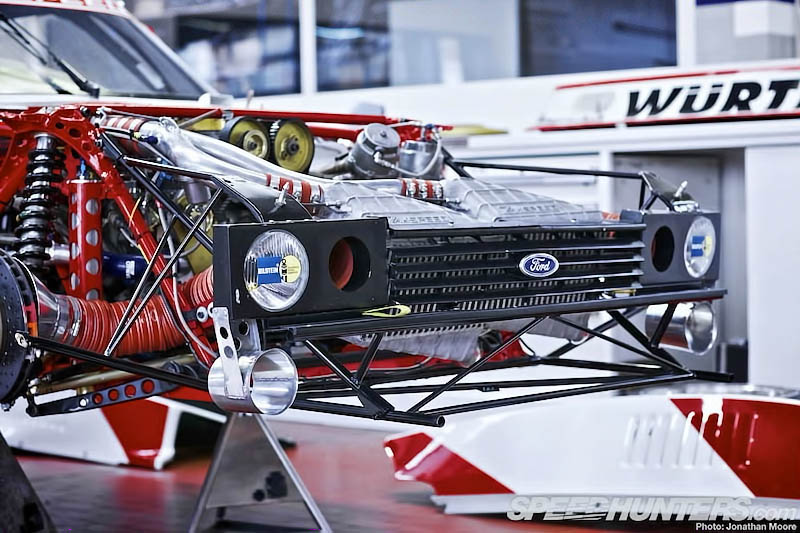
Although the front lights weren’t dictated in the rules (hence the slab front of the 935), Zakspeed stuck with the stock slatted grill and iconic quad-lights, further increasing the Group 5 car’s link with the road-going market.

As with modern racers, the driver is positioned as far to the rear as possible, with the wheel and main instrument cluster adjustable to suit. Ludwig managed to get one concession to comfort – the cut-out to the right of the bucket seat to give him more room for shifting. In front, the switchgear was kept to an absolute minimum, with the focus on a small set temperature gauges covering the critical functions.

Two things stand out on the dash, literally: oversized dials for controlling turbo boost (top) and brake balance (bottom). What a refreshing change from over-cluttered modern dashes, where you have to focus on which dial to go for whilst under pressure. Big top one: make fast faster. Big bottom one: make different slows. Perfect!

In the rear is the 100-litre FIA-spec ATL fuel cell along with the battery, the four four fuel pumps and the dry sump.

Everything was of the highest standard. Wiring through the car was aerospace standard: the Zakspeed name flowed through the Capri, but Ford investment provided that extra boost and half-mil silver-wire cabling was used. More fractional weight savings, but every gram would count. The Capri Turbo would weigh in at just 790kg.
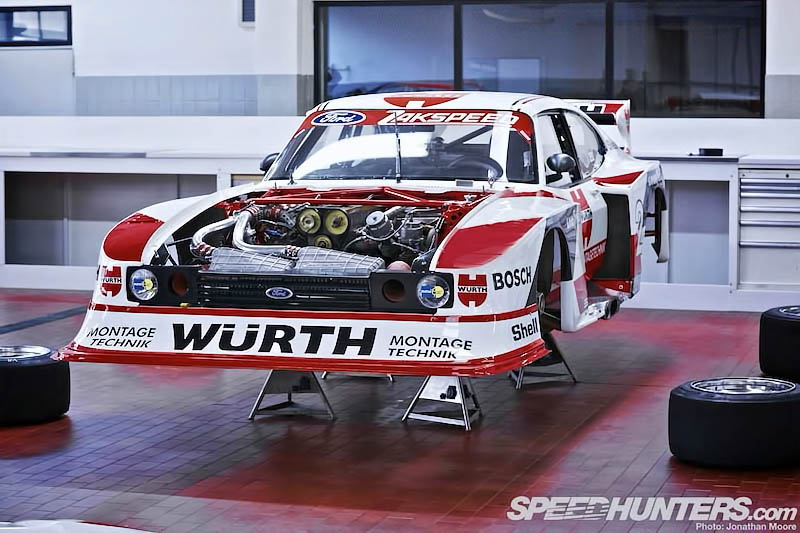
So it was light, but was it fast? The engine might have seemed teeny tiny in the cavernous nose, but when you examine it you realise just what insanity is at work. The block is mounted well back in the chassis and slightly offset to help optimise weight distribution, but what’s up front gives the game away.

Initially the Capri was entered into the DRM Division 2 class (for sub 2-litre NA engines or 1.4-litre turbos) with a Kent-based unit: a poor little ’60s-spec inline-four BDA was rebuilt by Zakspeed and smothered with bullying twin KKK turbochargers, Garret intercoolers and Bosch fuel injection.

The power was delivered through a Getrag-sourced, five-speed gearbox: 380bhp and a top speed of 170 mph was hardly a bad result – but the pressure on the small engine caused numerous problems, particularly broken pistons, camshafts and cracked rotors. It’s a common problem even today – vis the modern rallycross Supercars.

These issues were got round by moving to a single but larger KKK turbocharger and using twin intercoolers. A blow-off valve controlled the level to keep things within the regulation limits. The Garrett intercoolers were cast by Zakspeed, and the dual layout adds that extra kick of cooling before the air is charged into the turbo: originally there were a pair because of the two turbos, but it was found that the layout worked well even with a single turbo to feed.

By the end of 1980, the Division 2 car was delivering over 450bhp at 9200rpm. One thing you’ll notice here is that there’s an important part of the power delivery system missing…

…as it was on the workbench awaiting reassembly!

The primitive ECU (by modern standards) and ignition management are located under a service hatch by the transmission tunnel, with the fuel injection provided by Bosch. Accessibility was an important part of the build, and all major components can be accessed directly or via removable panels.

The exhaust exits out of the left side, which makes for great gobs of fire being thrown out under braking – the tubes have been flattened down into rounded rectangles to work with the flat underbody, but still they were vulnerable to damage.

Another problem to tackle was heat. The Capri is covered in heat-dissipating devices: a chrome-nickel alloy exhaust manifold helped up front, and then there were the bespoke, curving side radiators in the front of the rear fenders – these were Citroën units bent into shape – and separate oil coolers the rear axle, the gearbox and engine oil.

The front suspension followed Formula 1 convention of using isosceles triangle aluminium wishbones in conjunction with screw-adjustable ball-joints. Lightweight McPherson struts worked in combination with Bilstein shocks: single-gas-padded tubes with concentric titanium springs supporting adjustable aluminium spring plates. Compression and rebound damping and ride height control was all controllable.

The rigid live rear axle was made from a light alloy, though the material went through some iterations to find something that could withstand the power, and the housing was set up with positive camber and tie bars to control toe. The rear shocks used the same set-up as at the front.

Twin cast-aluminium Girling brake callipers on vented and perforated disks were used on each front wheel: water cooling could be added if necessary.

At the rear, larger single-calliper disks provided the braking power.

The first car, in classic Mampe colours, was run out halfway during the 1978 DRM season, and immediately wowed the German public – it was dubbed the ‘Wunderwagen’ by the press – and scored four poles and a win. In ’79, its second season, three Capris were entered and they swept the Division 2 title, winning the majority of races – but the Klaus Ludwig’s Division 1 935 was still winning outright. It was time to get a bigger boat. And a new pilot for the bigger boat.

The result was the 1980 Division 1 (for 2-litre and over NA cars, or 1.5-litre and over turbos) version, in combination with legendary driver Klaus Ludwig jumping ship to Zakspeed (via a court case). The engine was bored out to 1.7 litres and the twin-turbos came back; the front splitter and rear wing got even more extreme.
A savage 600hp beast, the Division 1 car put the opposition to the sword. 10 seconds faster than the Division 2 model, its advanced aero, 186mph top speed and power-to-weight advantage put it right up there with the 800hp Porsches.
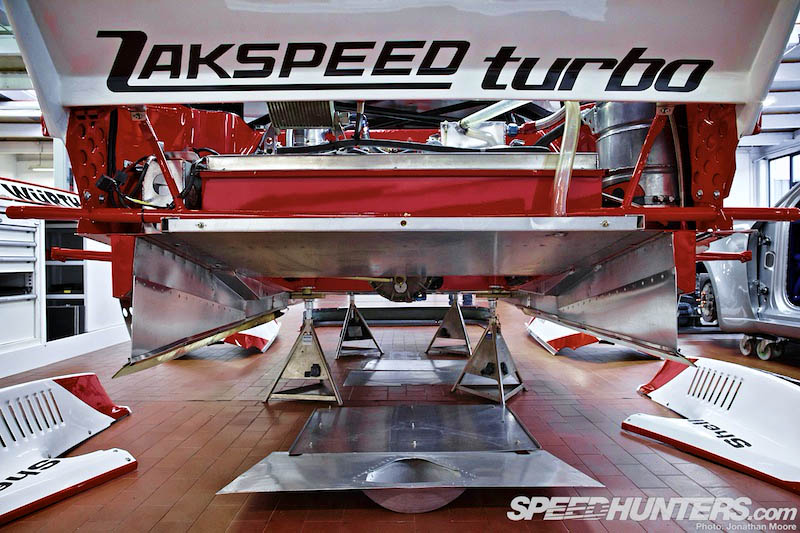
The over-wide wing was soon protested and banned, so Zakspeed simply deployed more engineering skill. The underside of the car was revised with an advanced F1-style, full-length ground effect venturi tunnel with flexible side skirts. This was serious stuff. The rear diffuser slot created negative pressure, pulling the Capri down through Germany and towards Australia. The side skirts would soon wear down, decreasing the effect, but it still made the car almost untouchable in early laps. However, Ludwig had been stripped of the points for his wide-wing wins, so those pesky Porsches still took the title…
In 1981, Manfred Winklehock took to Division 1 with a LiquiMoly-sponsored car and blitzed the class; Klaus Ludwig switched back to a Würth Division 2-spec Capri with the advanced aero fitted and took 11 wins to Winklehock’s six – stealing the overall title.
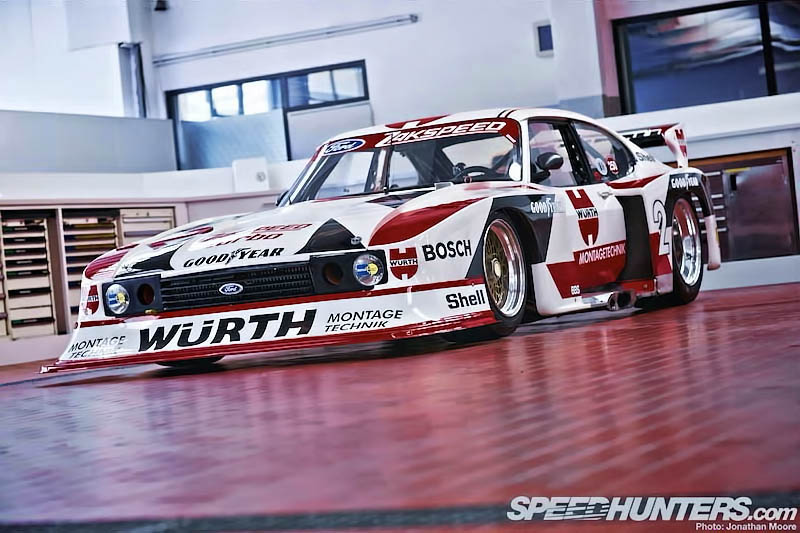
This is his car from that year, with the livery reversed from the white and red on black of ’80 to this stunning black and red on white.
It was the final chance for the Capri: from ’82, Group C cars became top dog, though Division 1 Capris continued to compete until the end of ’83. The car lived on, used as the basis for the IMSA Mustang in the USA, plus the engine formed the basis for the unit Zakspeed would use for their foray into Formula 1:. We’ll have more on that in a Zakspeed shop tour coming up later this month.

One of the most striking things about the Zakspeed Capri was its range of liveries: all the cars raced with striking but simple geometric designs that were full of character, easily identifiable and perfectly complement the long shape of the Capri Turbo.

Zakspeed’s restoration of Ludwig’s car has been accurate to the ’80s in almost every way. The spaceframe was crack-tested and repaired as necessary, and a new subframe manufactured. All the mechanicals are as per the original, and the body panels have been remade using the original wooden jigs – but the difference is that this time round carbon-fibre has been used for all major panels and the front wing is the wider 1982 Division 1 spec.
The effort put in by Zakspeed was given its ultimate reward by the car being invited to the 2012 Goodwood Festival Of Speed, with Klaus Ludwig himself taking the Capri up the famous hill. It’s also competed in the hands of current Zakspeed owner and son of Erich, Peter Zakowski: he ran at the Oldtimer Grand Prix at the Nürburgring. Enjoy this video for some glorious on-board action from this very car: he’s still hunting K3s, just like in the old days.
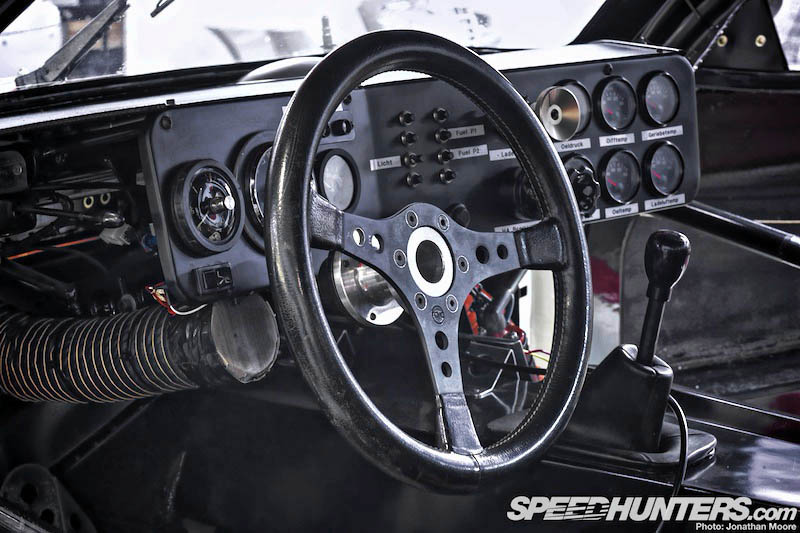
Me, I still have all my old toy cars in boxes in the garage. I’m a terrible one for hoarding. Oh, and now a Würth Zakspeed Capri slot-car that is very much a more recent purchase. And. Ah. Two more in the post. Sometimes writing articles like this can be a very expensive business…
Jonathan Moore
ZAKSPEED FORD CAPRI TURBO GROUP 5
ENGINE
Front-longitudinal Ford Cosworth BDA four-cylinder, alloy head with 16 valves.
Capacity 1,426cc (80mm bore x 71mm stroke)
Zakspeed assembly, some Cosworth components
KKK turbocharger, boosting to 1.5 bar
Bosch Fuel Injection
DRIVELINE
Getrag 5 speed manual (geared for rolling start)
Sachs twin-plate clutch
ZF 90% torque differential
SUSPENSION/CHASSIS
MacPherson struts/Bilstein shocks
Space frame chassis from welded alloy piping
Quick lift jacks
BRAKES
Ventilated and drilled disks all-round (12.87″ front/11.86″ rear)
Twin 4-piston calliper (front), single 4-piston calliper (rear)
Cockpit adjustable
WHEELS/TYRES
Front: BBS 10″ rim x 16″ tyre
Rear: BBS 12.5″ rim x 19″ tyre
Tyres: Goodyear 10.0/225×16 (front) 12.5/27.5×19 (rear)
COCKPIT
Sheet steel cockpit
Integral roll-cage and extinguisher system
BODY
Carbon-fibre body panels
Plexidur 3mm glass
PERFORMANCE
1.5 max bar boost giving 460 bhp @ 9200 rpm
Top speed: 174 mph
Weight : 790kg
Length: 5060mm
Width: 1980mm
Height: 1150mm
Wheelbase: 2550mm
Track (F/R): 1550mm/1775mm















one of the best looking race cars ever, thanx for such tech look..... but what are they doing with chyrsler 300c in the background?
I suppose I'll have to go to this year Oldtimer, then!
Amazing feature Jonathan, stunning car, pics and write-up.
Looks like a v8 superstars car to me.
What an amazing piece of engineering. Great feature!
I am curious what model kkk turbo that was?
perpetualroad.wordpress.com
F*ck them Porsche's were quick on the straights. I was willing the Capri on one point. If only it had more power. Great article by the way!
Awesome article
Great article. Now do the Porsche Baby Turbo
@izzy_ortiz It is a K28 I think or something like that. It is very rare and very sought after. If you find one they tend to be in the $4k range. Its a very brutal turbo capable of some crazy numbers.
this article is exactly the reason i check this place daily
great work JM
to put it into perspective, what does a car like this run at say, Spa, vs a modern GT class car?
"make different slows" hahaha. I LOL'd so much.
Want
here's another modern video of it: http://www.youtube.com/watch?v=qaGjYGtOAJs&list=FL0ru5Xv5tdx-PNaRKsVP_2g
awesome article! love the homage shot there.
so...did your dad's tamiya models survive your childhood or did you also play with them?
Aluminium rollcage??
One thing that I really love about your articles is that you don't just list specs, it's quite a lot on emotion and stuff like that.
Keep being awesome.
One thing that I really love about your articles is that you don't just list specs, it's quite a lot on emotion and stuff like that.
Keep being awesome.
One thing that I really love about your articles is that you don't just list specs, it's quite a lot on emotion and stuff like that.
Keep being awesome.
Great article thank you very much. Keep the articles coming. Love videos and pictures.
Great article thank you very much. Keep the articles coming. Love videos and pictures.
Great article thank you very much. Keep the articles coming. Love videos and pictures.
This car is totally beast mode on...
quite funny to stumble across this here... (my first visit at this site) as I just saw that car in the flesh last weekend at the Bremen Classic Motorshow along with some other Group 5 and Group B Monsters - found it quite to difficult to recognize what it´s based on at first glance - it really is quite an outrageous machine!
Don't normally fall for Capris. But the details from this article changed it all. As usual, great job Mr JM!
Don't normally fall for Capris. But the details from this article changed it all. As usual, great job Mr JM!
Don't normally fall for Capris. But the details from this article changed it all. As usual, great job Mr JM!
After seeing and driving this car in Forza 6, I just had to research it. Loved the in depth article explaining both the car and it's history.
After seeing and driving this car in Forza 6, I just had to research it. Loved the in depth article explaining both the car and it's history.
What a great article on the Zakspeed Capri. I have a friend here in New Zealand who has painstakingly restored one of the Grp 2 / 5 Mk2 Escorts back to its original condition. I would love to see an article done on this car as it was the Ex Hans Heyer car. This is still being raced out here in New Zealand under the Historic Class. What a beautiful car and so lovingly and painstakingly restored by Gary Wilkinson.
That ZAKSPEED FORD CAPRI TURBO GROUP 5, dreamed car, is a totally, monster, beast, I love it.
Greetings.
This car now lives in NZ. Have just seen it at Leadfoot festival along with a 1977 zakspeed escort. Beautiful cars in the flesh
nice post